The preparation of Graduate Learning Outcomes (GLO) in the 2022 curriculum of the Chemistry Study Program UII is done in 3 stages, i.e., the determination of the graduate profile and the formulation of the GLO, the determination of study materials and the formation of courses, and the preparation of a matrix of course and curriculum maps. The preparation of this CLO refers to Permendikbud No. 3 of 2020 concerning National Standards for Higher Education (SN-Dikti), Presidential Decree No. 8 of 2012 concerning the Indonesian National Qualifications Framework (KKNI), and Guidelines for the Preparation of Higher Education Curriculum in the Industrial Era 4.0 to support MBKM.
The first stage begins with determining the profile of graduates and formulating GLO based on the results of graduate searches, feedback from stakeholders, professional associations, scientific consortia, trends in future scientific/skilled development, and the evaluation of former curriculum. The CSP has conducted a group discussion forum (FGD) for the preparation of GLO through the selection of an external advisory board, associations, stakeholders, and alumni users. FGD discussed the preparation of GLO based on the MBKM curriculum to measure the GLO. Based on the evaluation of the 2017 curriculum and the responses of each representative of the association, stakeholders, and alumni users, the curriculum team conducted a review of the GLO. Furthermore, socialization of new GLO and their distribution in courses to lecturers held through Forum Group Discussion (FGD). These activities were conducted in each Expert Group (KK) to discuss the GLO design and its distribution in courses.
Then, the panel discussion was continued by the department council to determine the “ESSENTIAL” which is expected to be in line with the latest demands to survive, improve, and grow through the Implementation of the MBKM Adaptive Curriculum. Figure 1 shows a schematic process to produce the “ESSENTIAL” GLO. It is hierarchically integrating the vision and mission of the CSP with several factors, such as UII local wisdoms, competitive advantages, and research advantages.

Figure 1. Schematic of the GLO acquisition process
The second stage is the determination of study materials and the formation of courses. Study materials and learning materials in the 2022 curriculum have been updated and developed according to the development of Science, Technology and the Arts of Science and Technology and the direction of the development of chemistry. To achieve the desired Graduate Competency Standards (GLO), the Chemistry Study Programme (CSP) has determined several study materials. In general, the study materials in the 2022 curriculum include basic attitudes or ethics, knowledge and skills, and self-development.
The process of determining the study material has been carried out by involving every Expert Group (KK) in the CSP. Based on the study materials that have been determined, then they are described in more detail into learning materials. The level of breadth and depth of learning material refers to the GLO as stated in SN-Dikti Article 9 Paragraph (2) of 2015. Graduates of the undergraduate program are expected to be able to master the theoretical concepts of certain fields of knowledge and skills in general and the theoretical concepts of the special sections in these areas of knowledge and skills. in depth. In detail, the study materials include the following:
- The main study material for chemistry related to the mastery of knowledge in specific fields of the development of chemistry.
- Study materials related to the knowledge needed to conduct research and apply chemistry.
- Study materials related to religious attitudes and values as well as language and technology skills.
- Study materials related to basic knowledge of science and mathematics.
- Study materials related to mastery, skills, and soft skills and hard skills.
Figure 2. Flow of curriculum preparation process in the Chemistry Study Program (CSP) 2020.
Adjustments between the competence profile and the curriculum are conducted regularly every five years alongside the curriculum evaluation process. The objective of this process is to adapt user requirements.





